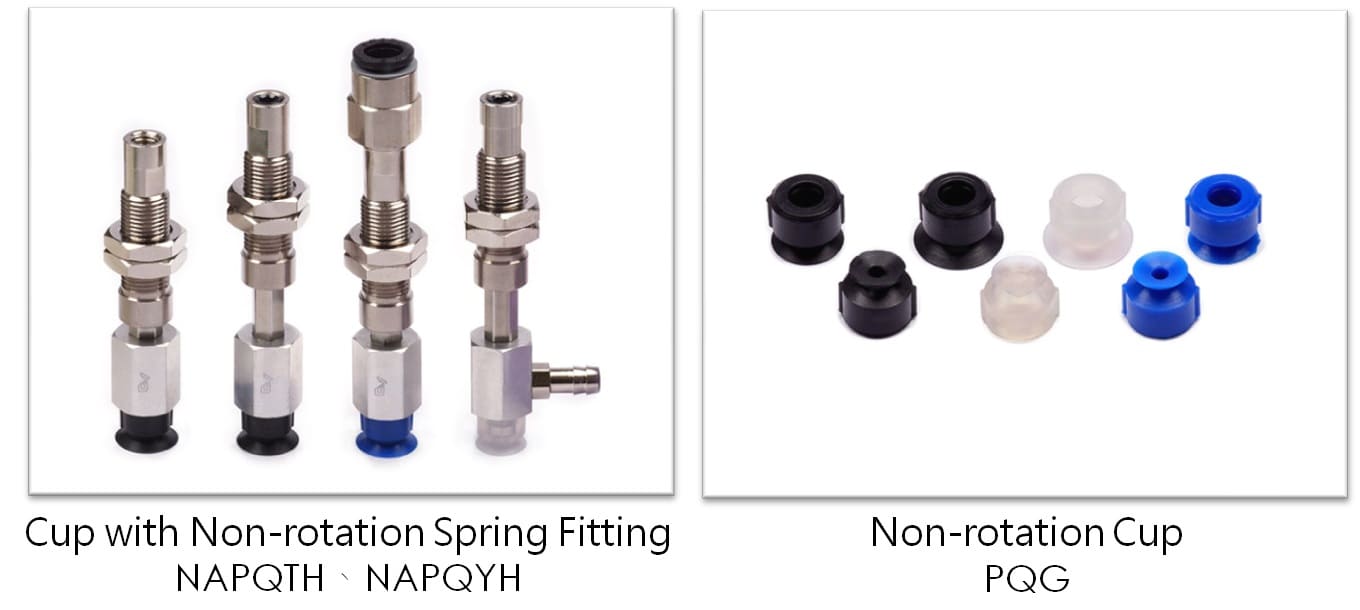

- All Products
- Pneumatic Series
- GENTLE Pneumatic Fittings
- GENTLE Ionizer
- CONVUM Ltd.
- FUJIKURA
- FUJI LATEX Co., Ltd.
- KOGANEI Corporation
- iB series
- Air Cylinders, Hands
- Air Valves
- Air Filters, Regulators, Pressure Gauges
- Flow Rate Sensor Switches, Plachain Ducts, Pressure Switches
- Vacuum Equipment, Pads
- Electric Actuator
- Environmental Hygiene Equipment
- Static Electricity Removal
- Fluororesin Products
- Fixed Discharge Pump
- Medium Control Equipment
- Pulse Blow Series
- NKE Corporation
- TAKEX
- Dispensing Series
- Anti-Rotation Structure: Built-in rotation stop keeps the cup from twisting at the mount—stable alignment and precise placement.
- For Smooth / Deformable, Orientation-Critical Parts: Ideal for thin sheets, soft media, and parts requiring a fixed orientation (labels, keyed terminals, etc.).
- Size Range: ø6 / 8 / 10 mm.
- Material Options (Code | Material | Key traits):
- N | NBR: general-purpose, oil resistant.
- S | Silicone: soft, conformable, low marking.
- U | Urethane (PU): wear resistant, quick rebound.
- F | FKM (Fluoroelastomer): heat & chemical resistant.
- NE | Conductive NBR: ESD conductive.
- SE | Conductive Silicone: ESD conductive, soft.
- Applications: Precision electronics assembly, orientation-specific labeling/placement, thin-sheet handling, stations where rotation must be prevented to avoid scuffing or misalignment.

Q1: What parts and use cases are PQ pads best for?
A: Precision electronic parts, thin sheets, and orientation-critical components—such as those with keys, locating grooves, or directional marks—where rotation must be prevented during handling.
Q2: What is the key difference between PQ and standard pads?
A: PQ features a non-rotation structure at the mount, preventing the cup from twisting during pick and place. This improves positional accuracy and yield.
Q3: Are PQ pads suitable for high-speed automation?
A: Yes. Their lightweight design supports fast pick-and-place. For best stability, tune vacuum orifice and motion profiles (accel/decel) to your equipment.
Q4: What sizes are available?
A: ø6, ø8, and ø10 mm. Select based on part size, effective contact area, and payload requirements.
Q5: Can PQ handle rough or stepped surfaces?
A: PQ is optimized for smooth, orientation-sensitive parts. For rough/uneven surfaces, consider PD (foam) or PL (multi-bellows) series for better conformity and sealing.
Q6: What material options are offered for PQ?
A: N (NBR), S (Silicone), U (Urethane), F (FKM), NE (Conductive NBR), and SE (Conductive Silicone). Choose by needs such as oil resistance, softness/conformability, wear resistance, chemical resistance, or ESD conductivity.


